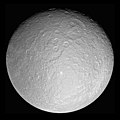Figura:PIA07763 Rhea full globe5.jpg

Amzure dë sta preuva: 600 × 600 pontin. Àutre arzolussion: 240 × 240 pontin | 480 × 480 pontin | 768 × 768 pontin | 1 024 × 1 024 pontin | 2 048 × 2 048 pontin | 4 920 × 4 920 pontin.
Archivi original (4 920 × 4 920 pontin, amzure: 2,67 MByte, sòrt MIME: image/jpeg)
Stòria dl'archivi
Ch'a-i daga un colp col rat ant sna cobia data/ora për ës-ciairé coma a restèissa l'archivi ant col moment-là.
| Data e Ora | Miniadura | Amzure | Utent | Coment | |
|---|---|---|---|---|---|
| dël dì d'ancheuj | 09:15, 27 Aos 2018 |  | 4 920 × 4 920 (2,67 MByte) | PlanetUser | Reverted to version as of 08:13, 13 March 2015 (UTC) |
| 12:09, 15 Aos 2018 |  | 4 920 × 4 920 (2,66 MByte) | The NMI User | Reverted to version as of 23:49, 14 August 2018 (UTC) | |
| 01:59, 15 Aos 2018 |  | 4 920 × 4 920 (2,64 MByte) | The NMI User | rv, fixed | |
| 01:49, 15 Aos 2018 |  | 4 920 × 4 920 (2,66 MByte) | The NMI User | Try making black | |
| 01:44, 15 Aos 2018 |  | 4 920 × 4 920 (2,65 MByte) | The NMI User | Fixed | |
| 10:09, 13 Aos 2018 |  | 4 920 × 4 920 (3,67 MByte) | The NMI User | Removing black borders | |
| 10:01, 13 Aos 2018 |  | 4 920 × 4 920 (2,67 MByte) | The NMI User | Reverted to version as of 08:13, 13 March 2015 (UTC) | |
| 09:56, 13 Aos 2018 |  | 4 920 × 4 920 (5,67 MByte) | The NMI User | Black background | |
| 10:13, 13 mar 2015 |  | 4 920 × 4 920 (2,67 MByte) | MoreTomorrow | making square (to match other planet/moon images) | |
| 08:43, 30 Otó 2008 |  | 4 920 × 4 820 (2,68 MByte) | WolfmanSF | This is the same full-resolution NASA image, with black panels added to the margins and some Photoshop processing to enhance contrast. |
Anliure a le figure
Le pàgine sì-sota a l'han andrinta dj'anliure a sta figura-sì:
Dovragi global dël file
J'àutre wiki sì sota a deuvro st'archivi-sì:
- Usagi dzora af.wikipedia.org
- Usagi dzora ar.wikipedia.org
- قالب:المجموعة الشمسية
- قائمة أجرام المجموعة الشمسية مرتبة حسب الحجم
- قائمة أجرام النظام الشمسي المستديرة بالجاذبية
- قائمة الأقمار الطبيعية
- خط زمني لاكتشاف كواكب المجموعة الشمسية وأقمارها
- اكتشاف واستكشاف النظام الشمسي
- قائمة أنواع الكواكب
- بوابة:زحل/مقالة مختارة وصورة لأحد أقمار زحل
- قائمة أكبر الفوهات في المجموعة الشمسية
- 1981 ميداس
- Usagi dzora ary.wikipedia.org
- Usagi dzora arz.wikipedia.org
- Usagi dzora ast.wikipedia.org
- Usagi dzora as.wikipedia.org
- Usagi dzora azb.wikipedia.org
- Usagi dzora be.wikipedia.org
- Usagi dzora bh.wikipedia.org
- Usagi dzora ca.wikipedia.org
- Usagi dzora ckb.wikipedia.org
- Usagi dzora de.wikipedia.org
- Usagi dzora el.wikipedia.org
- Usagi dzora en.wikipedia.org
- Pioneer 11
- Rhea (moon)
- Cassini–Huygens
- Timeline of discovery of Solar System planets and their moons
- List of geological features on Rhea
- Naming of moons
- List of natural satellites
- List of gravitationally rounded objects of the Solar System
- Wikipedia:WikiProject Astronomy/Recognized content
- Portal:Solar System/Selected picture
- User:Dabomb87/Sandbox
- Tirawa (crater)
- Rings of Rhea
Varda l'usagi global dë st'archivi-sì.


